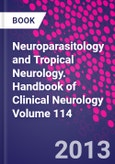Please Note: This is an On Demand product, delivery may take up to 11 working days after payment has been received.
Table of Contents
Section 1 Introduction Neurological aspects of neglected tropical diseases
Section 2 Pathophysiology and characteristics Mechanisms of CNS invasion and damage by parasites; Immunodiagnosis of CNS Parasitic Infections; Imaging of CNS parasitic infections; Pathology of CNS parasitic infections
Section 3 Protozoa Cerebral malaria; American Trypanosomiasis; Toxoplasmosis; Entamoeba histolytica brain abscess; Infections with Free-Living Amebae; Human African trypanosomiasis; Microsporidiasis; Neurological Neurologic Manifestations of Human Leishmaniasis; Neurologic Manifestations of Human Babesiosis
Section 4 Nematoda Eosinophilic Meningitis; Toxocariasis; Strongyloides stercoralis infection; complicating the central nervous system; Neurological manifestations of filarial infections; Neurotrichinellosis; Baylisascaris Larva Migrans; Other helminthic infections: Ascariasis, Dracontiasis, Lagochilascariasis, Micronemiasis
Section 5 Trematoda Schistosomiasis of the nervous system; Paragonimiasis; Direct and indirect affection of the central nervous system by Fasciola infection
Section 6 Cestoda Neurocysticercosis; Cystic and alveolar echinococcosis; Other cestodes Coenurosis, Sparganosis, Taenia crassiceps cysticercosis
Section 7 Other tropical neurological pathologies Neurological effects of venomous bites and stings: snakes, spiders, and scorpions; Effects of geohelminth infections on neurological development; Nutritional disorders in tropical neurology








